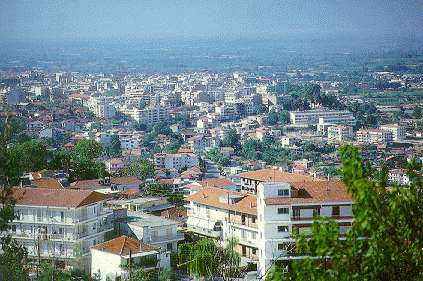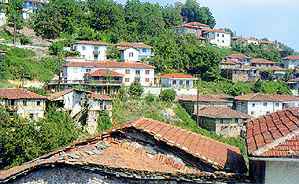|
|
Imathia

Veria:
As with many of the greek
cities there are various myths about the origin of the name
Veria (mainly because our ancient Greeks did not like gap in
their history. The most popular mythological explanation is
the one suggesting that the name comes from that of the nymph
Veroi, the daughter of Ocean and Thetis, who after being born
in the sea kingdom of her parents started wandering around and
was so enchanted from our region that chose it as her abode
and gave it her name.
Geographical location: With a population of approximately 50,000 and with a vivid
activity in many fields, Veria is one of the most important
towns of Central Macedonia. Built on the eastern slopes of
mount Vermio, at an altitude of 50 m, it is located 72 km west
of Thessaloniki. From here it is very easy to visit the
marvelous royal tombs of Vergina, where Philip II, the father
of Alexander the Great, is buried or the Macedonian tombs of
Lefkadia and the school where Aristoteles taught. Also within
easy reach of the town are the ski resorts of Seli and
Tria-Pente Pigadia.

Economy: The economy
of Veria is mainly based on agriculture and trading. The
fertile grounds of the region produce a variety of fruits and
vegetables which are exported all around the world. Veria is
also a very active export center, the main exported goods
being fresh and preserved agricultural products, threads and
cotton. Many of the goods exported through Veria come from
other regions of Greece.
History: The traces of Veria are lost deep in time.
The exact date of its founding is not yet known but American
archaelogists have excavated the earliest European farming
settlement, dating to the 6th or 7th millenium B.C., just a
few kilometres outside the town; therefore making it safe to
assume that it could in fact be one of the oldest towns on
Earth! The oldest verified reference to Veria is the first
book of Thucydides' History where it is mentioned that the
Atheneans, while on an expedition against Halkidiki, tried to
conquer the town (without success). Throughout the 2,500 years
of its history it has been one of the main commercial,
cultural and administrative centres of Macedonia.
Churches: There
are 48 Byzantine and post-Byzantine churches in Veria, 40 of
them with extensive frescoes. Some of the churches date back
to the 11th century, making Veria an important centre of
Byzantine ecclesiastic architecture.

Traditional architecture: Apart from
the wonderful churches one can also look forward to seeing
examples of traditional Greek architecture. Since the modern
town of Veria evolved over and around the centre of the old
town, many parts of the old town have been destroyed. The ones
that survived almost intact until today are the Jewish
quarters, the Kyriotissa area and the residences of
Kontogeorgaki st. All these are protected under law and every
effort is being made for them to be restored and put into
active use.The restoration and restructuring of the historic
centre of Veria is one of the main concerns of the
Municipality of Veria.
|
>> Macedonia :
Drama,
Florina,
Grevena,
Halkidiki,
Imathia,
Kastoria,
Kavala,
Kilkis,
Kozani,
Pella,
Pieria,
Serres,
Thassos Island,
Thessaloniki.
|
|